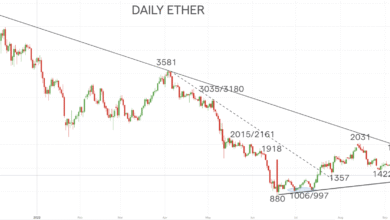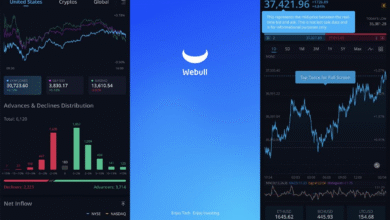Fat Apps Are Transforming the Crypto Landscape

Fat Apps are revolutionizing the crypto landscape as traditional notions like the Fat Protocol thesis come under scrutiny. Recent developments, such as the rise of tokenized equities, highlight a shift where applications, rather than foundational protocols, are beginning to capture significant market value. This new narrative builds momentum as investors increasingly focus on cash flows and revenue generation rather than simply relying on the dominance of Bitcoin. With crypto revenue soaring, many are looking for signs of an impending alt season, spurred on by potential regulatory advancements like spot altcoin ETFs. As we navigate this evolving landscape, Fat Apps are set to play a crucial role in defining the future of digital assets and their value creation.
In the realm of cryptocurrency, emerging applications, referred to as Fat Apps, are starting to outshine the previous emphasis on foundational protocols, challenging the long-held Fat Protocol thesis. This paradigm shift comes amid the introduction of new financial instruments like tokenized equities, which have stirred both excitement and skepticism among investors. As the crypto market looks toward institutions and their growing importance in this space, discussions on revenue generation and economic viability are becoming increasingly relevant. The anticipated rise of altcoins, driven by innovative strategies including spot altcoin ETFs, could redefine investment landscapes. In this context, the emergence of Fat Apps represents a transformative phase that prioritizes user engagement and actual cash flow over traditional metrics of success.
Understanding the Shift from Fat Protocols to Fat Apps
The transition from focusing on Fat Protocols to Fat Apps marks a pivotal moment in the cryptocurrency landscape. Traditionally, the Fat Protocol thesis posited that underlying protocols would capture the bulk of value in a decentralized ecosystem. However, the narrative is now shifting as investors begin to recognize the revenue potential of applications. This change is not just theoretical; it mirrors trends observed in the Web2 landscape where platforms like Google and Facebook accrued vast wealth, leaving foundational technologies in the dust. By embracing a more application-centric view, investors can identify opportunities where revenues are generated and realized, leading to potentially higher returns.
Fat Apps, which enable innovative solutions built on blockchain, symbolize this new era. The introduction of tokenized equities, for instance, underscores the application layer’s growing importance in driving user engagement and capital flow. As applications become more user-centric, focusing on delivering tangible value and facilitating access to decentralized finance (DeFi), their growth could outstrip traditional protocols. Hence, the market is changing its focus toward these applications to maximize returns, highlighting the need for investors to rethink their strategies accordingly.
The Challenges of Tokenized Equities and Market Expectations
The initial rollout of tokenized equities by platforms such as Solana and Robinhood may not have met user expectations, yet it represents a significant step towards the integration of blockchain technology in traditional finance. The promise of around-the-clock trading and enhanced liquidity is enticing, but the realization of these benefits requires time and trust from the community. As the infrastructure evolves and institutions like the DTCC begin integrating blockchain technologies, the way equities operate could fundamentally change, potentially reshaping investor sentiment and market dynamics.
Moreover, as the market navigates these changes, the anticipation of approval for U.S. spot altcoin ETFs could act as a catalyst for the next alt season. With investors keenly attuned to the movements of Bitcoin dominance, the timing and acceptance of these innovations will be crucial. Institutional confidence in tokenized equities will also be a determining factor in whether the market can sustain its rally and ultimately find a path toward broader adoption of these new asset classes.
Bitcoin Dominance: A Precursor to Alt Season
Bitcoin’s dominance in the cryptocurrency market has historically played a significant role in determining the timing of alt seasons. As institutional treasuries continue to accumulate Bitcoin, many in the crypto community remain in a state of watchful anticipation for the moment when Bitcoin’s dominance peaks. When Bitcoin edges toward new highs—such as the psychological mark of $100k—the ushering in of alt season often follows as retail investors turn their attention to alternative cryptocurrencies that may offer exponential gains.
Anticipation of market cycles is coupled with calls for careful investment strategies amongst retail investors. The informal polls and discussions circulating on platforms like Crypto Twitter highlight a community eager yet cautious. Many are beginning to question whether the plethora of Layer 1 and Layer 2 solutions will significantly affect Bitcoin’s standing or lead to a fragmented market. Understanding Bitcoin’s dominance and the conditions under which altcoins thrive could lead to more informed decision-making and investment strategies moving forward.
Revenue Generation in Crypto: A New Paradigm
A crucial element that investors are beginning to prioritize is the actual revenue generation capabilities of crypto projects. This focus signifies a paradigm shift as more stakeholders inquire about the sustainability of revenues within the blockchain ecosystem. Prioritizing projects that not only promise long-term technological advancements but also show concrete cash flow can lead to better investment outcomes. For many, it’s now clear: the viability of a cryptocurrency might hinge less on its underlying technology and more on how well it monetizes its user base.
This trend could lead to a wave of new app-focused projects that prioritize user benefits and financial returns. As Graham Stone humorously noted, discussing revenue in the crypto world was once seen as radical, but is now becoming a common rehearsal. Amidst this shift, it’s essential for investors to scrutinize not just the tokenomics of a project, but its capacity to generate revenue and translate that into value for token holders.
Fiscal Dominance and Its Implications for Crypto Investments
The increasing emphasis on fiscal policy over monetary policy is reshaping investment landscapes both within and outside the cryptocurrency market. With European Central Bank officials advocating for capital allocation in retail savings into development projects, the focus is shifting to how these macroeconomic changes will impact the adoption of crypto assets. Investors are keenly observing whether fiscal dominance can drive growth in crypto adoption, particularly as governments explore integrating more advanced financial instruments like tokenized equities into their economies.
This scenario has far-reaching implications not just for traditional equities but also for the blockchain space. If national policies begin favoring digital assets as legitimate forms of capital, this could trigger an avalanche of investments into cryptocurrencies. A fundamental change in how policymakers perceive and regulate cryptocurrencies could accelerate mainstream integration, which, in turn, offers new opportunities for investors interested in capturing emerging trends generated by these fiscal dynamics.
Adoption Challenges for Fat Applications
Despite the promising developments surrounding Fat Applications, there remain significant challenges to widespread adoption. Consumers need to be provided with clear benefits and assurances within a robust infrastructure that supports their needs. The initial wave of tokenized stocks, while innovative, did not fully deliver on user expectations, revealing the gap that still exists between technological capability and user experience. For Fat Applications to capture the market, developers must prioritize intuitive design and functionality that resonates with users exploring the blockchain for the first time.
Such hurdles often lead to skepticism, which can hinder investment. Nevertheless, as institutions start to integrate decentralized finance features and explore the potential of tokenized equities, we may begin to witness a gradual build-up of trust. The evolution and acceptance of these applications will, ultimately, depend on their ability to deliver effective solutions that improve user engagement, enabling their potential to be realized and potentially surpass the traditional legacy systems currently in place.
The Future of DeFi Composability and Blockchain Innovations
As blockchain technology continues to mature, the concept of DeFi composability emerges as pivotal for the evolution of Fat Applications. Composability allows various DeFi elements—such as tokens, liquidity pools, and lending platforms—to interact seamlessly, creating a more cohesive ecosystem. This interconnectedness can facilitate unique financial products and services that enhance user engagement and promote sustained revenue generation. The ability to leverage different DeFi protocols enhances usability and opens avenues for innovative applications that could redefine how users interact with finance.
This innovation wave creates an ecosystem where projects aimed at enhancing DeFi functionalities can benefit significantly. As Fat Applications evolve, the interoperability between these layers will be crucial in fostering user interest and driving investment. Investors should be on the lookout for projects that prioritize DeFi composability as they have the potential to yield substantial returns when adopted widely across the ecosystem.
Anticipating the Next Wave of Blockchain Integration
As the crypto landscape undergoes transformations, the anticipation of new blockchain integrations becomes palpable among investors and developers alike. The integration of tokenized equities, for instance, serves as an excellent example of how traditional investments can bridge into the cryptocurrency realm. Stakeholders in the industry are keen to observe how these integrations are executed and whether they offer substantial improvements over existing systems, especially in terms of efficiency, accessibility, and user interaction.
The future of blockchain may well depend on its ability to foster trust among users and investors. Successful integration will require seamless adaptations into existing financial frameworks to entice participants from traditional markets. By ensuring that these technological innovations address real market needs and enhance user experiences, the crypto market can position itself for unprecedented growth and market share in the years to come.
Reassessing Investment Strategies in Light of Market Trends
With the shifting dynamics of the cryptocurrency market, reassessing investment strategies becomes imperative for both institutional and retail investors. The emergence of tokenized equities, the changing narrative surrounding Fat Protocols, and the anticipation of alt coins gaining traction all hint at a necessity for adaptive strategies that respond to ongoing trends. Investors must begin to focus more on identifying projects demonstrating promise through actual revenues rather than solely relying on technology.
As macroeconomic factors, including fiscal policies and monetary strategies, play a significant role in shaping market opportunities, investors are encouraged to integrate these insights into their investment approaches. Adopting a proactive adjustment strategy can facilitate meaningful engagement with emerging applications, leading to the possibility of capturing value as Fat Apps become central to the cryptocurrency narrative.
Frequently Asked Questions
What are Fat Apps and how do they relate to the Fat Protocol thesis?
Fat Apps refer to applications that capture significant amounts of value in the crypto space, challenging the traditional Fat Protocol thesis that suggests base-layer protocols should dominate. As the market shifts focus towards revenue generation, Fat Apps highlight how applications can be profitable and beneficial for token holders.
Are tokenized equities considered Fat Apps in the current market?
Yes, tokenized equities, which enable 24/7 trading and greater accessibility, can be seen as a form of Fat Apps. Their integration onto the blockchain can create new revenue opportunities, reflecting the evolving narrative that applications can drive value rather than just underlying protocols.
How does Bitcoin dominance affect the potential for an alt season and Fat Apps?
Bitcoin dominance often precedes an alt season, where alternative cryptocurrencies could gain traction. This peak in Bitcoin market share may encourage a surge in investing in Fat Apps, as investors diversify into altcoins that promise innovative functionalities and revenue prospects.
What revenue models are driving the popularity of Fat Apps in the crypto industry?
Fat Apps are gaining traction due to revenue models that focus on cash flows and profits. As investors prioritize the financial performance of applications and their associated tokens, the emphasis shifts from speculative value to real-world revenue streams, enhancing the appeal of Fat Apps.
How are institutions shaping the rise of Fat Apps amidst the evolving crypto landscape?
Institutional interest in Bitcoin and the introduction of tokenized equities are pivotal in reinforcing the Fat App narrative. As institutions allocate resources to innovative applications that generate revenue, they validate the significance of Fat Apps as key players in the cryptocurrency market.
Can we expect more integration of traditional equity markets with Fat Apps in the future?
Absolutely. The integration of traditional equity markets with Fat Apps is anticipated as tokenized stocks gain adoption. This convergence will facilitate self-executing contracts and automatic dividend distributions, further blurring the lines between conventional assets and blockchain applications.
What challenges do Fat Apps face compared to traditional protocols in the crypto space?
Fat Apps confront various challenges, including user expectations, technology integration, and competition from emerging protocols. Despite their potential, the path to mainstream adoption requires overcoming initial rollout hurdles and demonstrating sustainable revenue generation.
What role do developments in decentralized finance (DeFi) play in the evolution of Fat Apps?
DeFi advancements are crucial in the evolution of Fat Apps, as they enable innovative functionalities like collateralized lending and asset management. This not only enhances the utility of Fat Apps but also aligns with the growing demand for applications that generate real financial returns.
| Key Point | Details |
|---|---|
| Market Dynamics | Markets paused while institutional Bitcoin accumulation continued. Tokenized equities entered the scene, challenging the Fat Protocol thesis. |
| Fat Protocol Thesis | The idea that base-layer protocols capture most value is under scrutiny; application-level revenue is becoming the new focus. |
| Macroeconomic Factors | Recent U.S. employment data shifted Fed expectations, highlighting the importance of fiscal policy over monetary policy. |
| Bitcoin Market Activity | Institutional adoption continues, but many feel under-allocated and are waiting for a significant altcoin season. |
| Tokenized Equities Launch | Platforms like Solana and Robinhood introduced tokenized stocks, though user expectation was not met initially. |
| Increasing Skepticism | The dominance of base-layer protocols is challenged by the success of application-based models (as seen in Web2). |
| Revenue Emphasis | A new focus on revenue generation for crypto projects is gaining traction, questioning the existing valuation models. |
Summary
Fat Apps are reshaping the narrative in crypto, as recent developments indicate a pivotal shift in how value is perceived and captured. With institutional interest in Bitcoin surging and innovative products like tokenized equities entering the market, the focus is moving from foundational protocols to the applications themselves. Investors are now more concerned about revenue generation and practical cash flows. As the crypto landscape evolves, the rise of Fat Apps signifies a transformative wave, crafting a new reality in digital finance.




